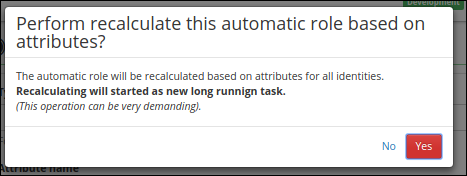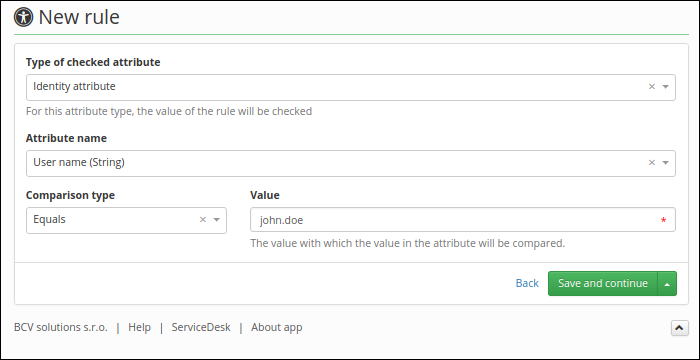Automatic roles by attribute
Automatic role by attribute is similar to automatic role by organization structure, both entities and dto's has same parent IdmAutomaticRole for entities and AbstractIdmAutomaticRoleDto for dto's. Both parent defined role and name attribute. Name attribute is only for better readability.
Definition
For automatic role by attribute exists two entities (and also dto's) IdmAutomaticRoleAttributeDto and IdmAutomaticRoleAttributeRuleDto these entities are in one-to-many (1:M) relation (automatic role by attribute has more definition of rules).
Attribute
Automatic role by attribute (dto IdmAutomaticRoleAttributeDto) has defined all attributes from his parent (AbstractIdmAutomaticRoleDto) and plus attribute concept see Inconsistent state. For automatic role by attribute isn't possible update role and name attribute.
- name - name of the automatic role by attribute (required),
- role - role that will be assigned after pass rules (required),
- concept - flag that sign that automatic role by attribute is not recalculate for users.
Rules
Individual rules for automatic roles by attribute, now is possible connect rules only with AND operator.
- automaticRoleAttribute - for what automatic role by attribute is this rule defined,
- formAttribute - for what EAV attribute is rule defined, only if rule is for EAV attributes (all form definitions for identity and contract are supported),
- attributeName - for what entity attribute is rule defined, only if rule is for entity attributes,
- type - enumeration
AutomaticRoleAttributeRuleTypedefined for with type is this rule (e.q. identity, contract, identity eav and contract eav), - value - value for comparison entity value,
- comparison - enum
AutomaticRoleAttributeRuleComparisoncontains all available comparison.- EQUALS,
- NOT_EQUALS,
- START_WITH,
- NOT_START_WITH,
- END_WITH,
- NOT_END_WITH,
- IS_EMPTY,
- IS_NOT_EMPTY,
- CONTAINS,
- NOT_CONTAINS,
- LESS_THAN_OR_EQUAL,
- GREATER_THAN_OR_EQUAL.
Comparison
Some comparison has limitation for attributes which can be used. For example:
Comparison LESS_THAN_OR_EQUAL and GREATER_THAN_OR_EQUAL can be used only with numeric attributes. Dont use it with another types.
For multivalued attributes (now only extended attributes - EAV) is available comparisons EQUALS, IS_EMPTY and IS_NOT_EMPTY. Comparison EQUALS search first equals value in all values. For example if exists rule equals=10 that exists for multivalued attribute that contains values 10, 20, 30 and 40. The rule will pass because equals search first value not all.
All another comparison is unavailable for multivalued attributes.
Comparison NOT_EQUALS, NOT_START_WITH, NOT_END_WITH and NOT_CONTAINS check null values empty strings "" (for entity attributes only). For EAVs doesn't exist value (entity IdmFormValue) when is empty or just doesn't exist. All these comparison pass when value doesn't exist.
Comparison CONTAINS and NOT_CONTAINS use classic like statement. We recommend use another type of comparison because with combination with another rules is possible that some performance problem appears. About performance and automatic roles see section performance.
Inconsistent state
After add, delete or update rule for automatic role by attribute is this automatic role in inconsistent state. Inconsistent state mean that is possible that some user has or hasn't assigned this automatic role event if it should be assigned or removed.
Inconsistent state we can repair by recalculate roles for this automatic role. Recalculation is done by long running task ProcessAutomaticRoleByAttributeTaskExecutor, this task need only id of automatic role by attribute. LRT assign role for all new users that pass rules and remove role for all users that already didn't passed.
Recalculation
Recalculation is process that recalculate automatic role for all users. In two db query is get all new users that pass the automatic role by attribute and all users that already din't pass. For these two set is create requests.
After save identity or contract values
For automatic role by attribute was created two new processor IdentityAutomaticRoleProcessor and IdentityContractAutomaticRoleProcessor both these processors catch event for UPDATE, CREATE and EAV_SAVE. After catch event is done recalculate all automatic roles only for identity that is save.
After add, remove or update rule
After update, delete or add rule for automatic role by attribute is this automatic role in inconsistent state (see Inconsistent state). User that update, delete or add rule is ask for immediate recalculation by modal window.

LRT
Long running task ProcessAutomaticRoleByAttributeTaskExecutor process automatic role (given in attribute), this task process all users. Long running task ProcessAllAutomaticRoleByAttributeTaskExecutor executes same process as ProcessAutomaticRoleByAttributeTaskExecutor but synchronously for all automatic roles by attribute. Is also useful recalculate all automatic roles once per day. For example contract/slice synchronization executes ProcessAllAutomaticRoleByAttributeTaskExecutor with HR process.

